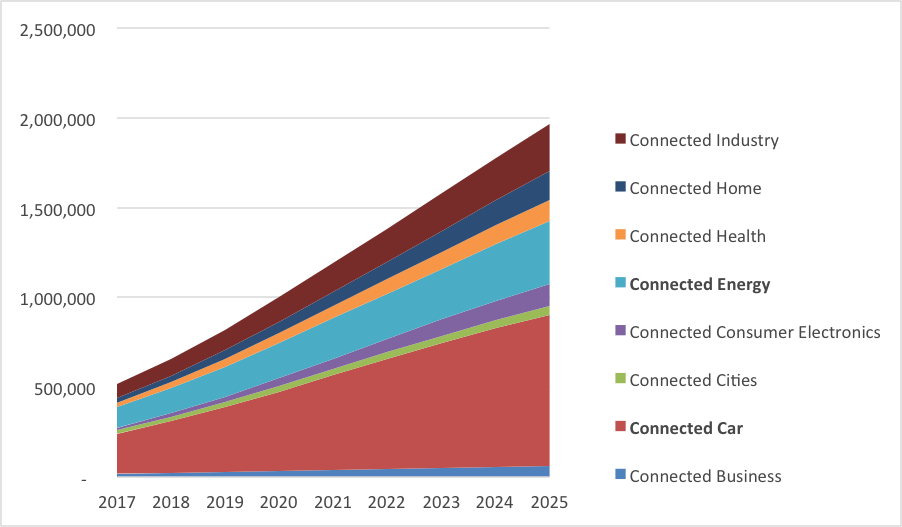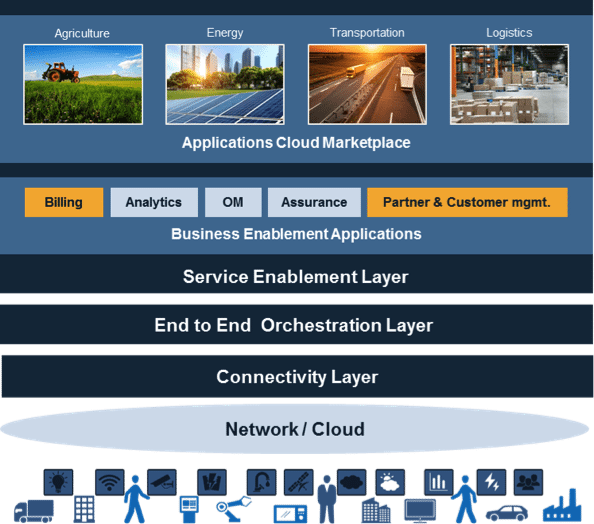The evolution of enterprise IoT services may be in its early days, but it is already clear that business models must be built around technology that can react in real time to quality of experience factors. IoT initiatives will not be successful based on simple, best effort approaches. They must be linked to a unified network, business and data management strategy that ensures the ecosystem is functioning, user experiences are high-quality and problems can be addressed quickly and with minimal disruption. Service providers should think about the breadth of management tools that provide a real-time view of the entire ecosystem and are capable of delivering and monetizing services while measuring performance and addressing problems. With proper analysis and application of the wealth of data that will be created, service providers can gain the most complete picture needed to ensure high-quality end user experiences today and over the long term.
Enterprise interest in IoT applications
The internet’s massive expansion of new end points is predicted to reach upwards of 50 billion new devices over the next 10 years, showing that consumers and enterprises will interact in new ways. With multiple connected sensors interacting within and across devices, the reality of over 1 trillion new data sources is within arm’s reach. In the internet of things technology space, business models will change to emphasize more personalization; real-time information; insightful decisions; easier personal and business lives; and more efficient processes.
Many enterprises see IoT’s value in increasing operational efficiency or improving long-term business reach and performance. Whether targeting SMBs or larger enterprises, the end goal of new IoT services is to help businesses scale and to drive new revenue. As new IoT services are embedded into the broader service portfolio, it augments the needs for transformation of both the service provider and the enterprise, and both of these will benefit from a broader approach to the right customer experience. This will be one of the leading points of any digital transformation. Newer digital services also force a move away from legacy business processes and enablers, all of which have their own paths.
A recent Machina Research report entitled “CSPs in IoT Benchmarking Report” gives great insight into how service providers bear significant responsibility in delivering substantial business and IoT cellular connection growth to support enterprise IoT devices and applications. Of the 17 service providers examined in the report, eight reported managing more than 10 million cellular connections for IoT. All respondents delivered double digit percentage growth in IoT connections, well outpacing their respective traditional businesses. While the CSPs did not report specific vertical segment IoT connection growth, recent CSP and customer conversations point to market traction and momentum in areas such as automotive and transport; energy and utilities; healthcare; and retail. Global market leaders such as Vodafone and AT&T saw connection growth several orders of magnitude greater than their traditional mobile phone businesses. In fact, these companies combined to support nearly 100 million IoT cellular connections across the globe. For the leading vanguard of service providers in IoT, the area is now a billion dollar or greater business unit.
IoT cellular connections by segment (000s), 2017-2025

Source: Machina Research
IoT services generate new requirements
For enterprises taking on IoT initiatives, the opportunities are diverse. IoT is not just one market. It comprises multiple markets with varying requirements, drivers and sub-ecosystems. When it comes to service providers specifically, much of the current opportunity resides in the connected car market, which spans the automotive and transport verticals and accounts for nearly half of all IoT cellular connections. Because the segment is poised to remain the largest through 2025, service providers are making significant investments and efforts in the connected car market.
The new enterprise IoT ecosystems will produce new services designed with new capabilities and requiring new levels of connectivity. With any endpoint they interact with, the end user must be met with a better experience. These IoT interactions will generate vast amounts of data that can be used to solve problems and to create high-quality user experiences for any new product and its services. It is also one of the most important aspects of IoT to manage.
IoT demands a new, faster, more capable and future-proof connected network for these new service offerings to succeed. The wireless industry has seen many technology shifts while evolving from 2G to 5G networks, and none of it would have been feasible without investment in new network and IT infrastructure.
IoT services clearly benefit from this transformation. As many endpoint sensors require minimal bandwidth and power to interact, network capabilities are likely to be of lower concern than the functionality behind them, especially as speed and bandwidth improvements reduce concerns around service quality. Low power, wide area (LPWA) access technologies, which are designed specifically for low bandwidth, machine-type communications, provide critical innovations that give service providers technical tools and economic means to address a broader set of IoT use cases and applications. LPWA lays important groundwork for the eventual arrival of 5G. It offers a catalyst to amplify the number of devices directly connected to a wide area wireless network.
While 5G is often touted for its high bandwidth and low latency, this is useful to only a minor subset of IoT applications. 5G’s benefits in areas such as network flexibility, provisioning, scalability, economics and security will see near term relevance because they will help boost service providers’ ability to serve IoT markets more effectively. It has become imperative for service providers building IoT businesses to explore investments in these technologies while carefully considering the timing and relevance of such investments.
Of course, connectivity with end points must be guaranteed to provide quality of service. One would expect that connectivity to be measured and monitored through network management and service quality management tools and guaranteed to the customer by strict service level agreements. Ongoing and upcoming technological innovations will without a doubt keep the benefits of IoT front and center, thereby expanding the overall addressable opportunity and ultimately the revenues that can be captured. Notwithstanding those issues, it is also important to remember that network transformation cannot function to its full capacity without a technology stack upgrade that involves new hardware; software; connectivity; real time BSS/OSS capabilities; security; partner management and support; and integration with related enterprise business systems.
Mastering the IoT user experience
The move to real-time and the use of next-generation BSS becomes a particularly critical factor not just for IoT relevance and success, but for longer-term improvement at the customer relationship level. For virtually any IoT service, more personalization and greater accuracy in billing, particularly outside the traditional intervals of a typical 30- or 60-day billing cycle, will improve the customer experience. It will put the enterprise on the same path to digital transformation as the CSP with which the enterprise partners. Real-time transaction management also gives customers the potential to access up-to-date levels of consumption information electronically, something they have already come to expect from their CSP.
In IoT, the overall user experience has both quantitative and qualitative components to it that any enterprise will want to leverage. The ecosystem management aspects must embrace everything from provisioning and ordering, all the way up the stack to customer management. This will all become critical to the success of any given business service. The number of interactions must be tracked, measured, and in certain cases, monetized based on the business models in question.
Service quality must be also measured based on defined principles that are part of product development and service delivery lifecycles. As with any technology, the lifespan of the “things” is finite, and overall service quality gets tied to the device or endpoint service quality. All of this must be managed. Enterprises can think of it in the way a typical mobile phone user thinks about the lifespan of his or her phone. Most wireless handsets can be linked to a trade-in or upgrade plan, based on the agreements between the service provider and the customer. Thus, service continuity and user experience take precedence over the device itself. The same can be said for the vast IoT ecosystem, except now, management of that ecosystem becomes the new challenge, and replacement or upgrades of the IoT endpoints becomes a management aspect itself.
A framework for IoT management
Managing these challenges highlights the utmost importance of effective operational support and related IT systems in the new IoT world. Managing such a complex ecosystem will require service providers to have a structured framework that provides fulfillment at the endpoint, IoT-specific orchestration, customer care, and settlements. This must all be organically interconnected and centralized, and must rarely require substantial revisions so as not to upset the ecosystem’s balance.
Thus, the greatest assurance of success for any IoT ecosystem is a technology foundation that enables:
• Easy access to IoT applications or services through a functional marketplace or platform strategy.
• Connectivity services for all end points, third party partners and end consumers.
• Applications that work seamlessly across the ecosystem, from the device through to orchestration, service and business enablement.
• Connectivity services for all end points, third party partners and end consumers.
• Operational support that embraces embedded data analytics technologies that provide real-time visibility into service delivery, service quality, assurance and ultimately a quality experience.

Finally, fundamental to IoT is the emergence of new business models and monetization approaches enabled by the leverage of real-time data that is more granular and accurate and which connected devices make possible. For service providers pursuing IoT, investments in key operational systems such as BSS/OSS platforms will be an important complement to ongoing network transformations. Not only must the network be able to handle the wide variety of bandwidth and scale internet of things use cases require, but operational systems must also be sufficiently robust and flexible so that new and creative ways of charging and billing for the IoT services can be enabled by leveraging the better data that becomes available via connected devices. To this end, effective service provisioning, fulfilment and revenue management will be critical for service providers looking to maximize the monetization potential of the IoT opportunities that are most relevant to them.
